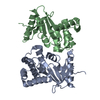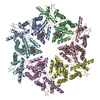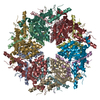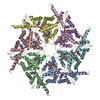+Search query
-Structure paper
| Title | Allosteric activation of VCP, an AAA unfoldase, by small molecule mimicry. |
|---|---|
| Journal, issue, pages | Proc Natl Acad Sci U S A, Vol. 121, Issue 24, Page e2316892121, Year 2024 |
| Publish date | Jun 11, 2024 |
 Authors Authors | Natalie H Jones / Qiwen Liu / Linas Urnavicius / Noa E Dahan / Lauren E Vostal / Tarun M Kapoor /  |
| PubMed Abstract | The loss of function of AAA (ATPases associated with diverse cellular activities) mechanoenzymes has been linked to diseases, and small molecules that activate these proteins can be powerful tools to ...The loss of function of AAA (ATPases associated with diverse cellular activities) mechanoenzymes has been linked to diseases, and small molecules that activate these proteins can be powerful tools to probe mechanisms and test therapeutic hypotheses. Unlike chemical inhibitors that can bind a single conformational state to block enzyme function, activator binding must be permissive to different conformational states needed for mechanochemistry. However, we do not know how AAA proteins can be activated by small molecules. Here, we focus on valosin-containing protein (VCP)/p97, an AAA unfoldase whose loss of function has been linked to protein aggregation-based disorders, to identify druggable sites for chemical activators. We identified VCP ATPase Activator 1 (VAA1), a compound that dose-dependently stimulates VCP ATPase activity up to ~threefold. Our cryo-EM studies resulted in structures (ranging from ~2.9 to 3.7 Å-resolution) of VCP in apo and ADP-bound states and revealed that VAA1 binds an allosteric pocket near the C-terminus in both states. Engineered mutations in the VAA1-binding site confer resistance to VAA1, and furthermore, modulate VCP activity. Mutation of a phenylalanine residue in the VCP C-terminal tail that can occupy the VAA1 binding site also stimulates ATPase activity, suggesting that VAA1 acts by mimicking this interaction. Together, our findings uncover a druggable allosteric site and a mechanism of enzyme regulation that can be tuned through small molecule mimicry. |
 External links External links |  Proc Natl Acad Sci U S A / Proc Natl Acad Sci U S A /  PubMed:38833472 / PubMed:38833472 /  PubMed Central PubMed Central |
| Methods | EM (single particle) |
| Resolution | 2.9 - 3.6 Å |
| Structure data | EMDB-43329, PDB-8vku: EMDB-43343, PDB-8vls: EMDB-43392, PDB-8vov: |
| Chemicals |  PDB-1ac1:  ChemComp-ADP: |
| Source |
|
 Keywords Keywords | HYDROLASE/ACTIVATOR / activator / complex / ATPase / AAA protein / HYDROLASE / HYDROLASE-ACTIVATOR complex |
 Movie
Movie Controller
Controller Structure viewers
Structure viewers About Yorodumi Papers
About Yorodumi Papers









 homo sapiens (human)
homo sapiens (human)